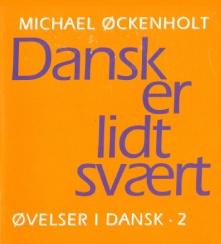
Hej,
Welcome to the “Prøve I Dansk 3” feedback series!
I am nearly finished with module 4.2, so I decided that it is time to start sharing more feedback about each of the modules.
These reviews and posts will definitely give you more insights if you are just starting to study Danish in Denmark. If you are already advanced and passed the early modules, then you may want to wait a little bit longer until I publish my feedback for module 5, PD3 Exam and module 6 (Studieprøven).
Please note that below feedback is based on my personal experience at Studieskolen in Copenhagen. The content of the modules that I describe is obviously subject to change with time (as per the national guidelines) and can vary slightly based on the teacher and the school.
If you feel like sharing your own feedback about your experience in learning Danish in Denmark, you are very welcome to contact me. I will gladly feature you on the blog!
In order to have consistency throughout theses module reviews, I will use the same analytical structure:
- Module expectations
- Module structure
- Module Test
- Book used
- Resources
- Personal feedback
Welcome to Module 1 feedback!
Module Expectations
Module 1 is probably the most crowded module of all. For the simple reason that (nearly) all the expats are enrolling in it, so they can get their first introduction to the Danish language.
Expect to be sitting in class with fellow students coming from various nationalities, various professional backgrounds and different language learning skills.
This module is a great introduction to the Danish language, where you will learn vocabulary to initiate a very basic introductory conversation. The grammar kicks off gently in this module, so do not stress yourself too much about it. It will get more intense in module 2 and module 3.
The module is well structured and interactive for beginners. Expect to also learn more about Danish culture and society.

Module structure
Module 1 is split into 2 levels: Module 1.1 and Module 1.2.
In the module 1 (and module 2 as well), expect the teacher to write a lot of vocabulary on the board. This will really build up your knowledge. In the later modules, they barely write vocabulary on the white board, as you are expected to understand the words (and looked them up in the dictionary upon your own initiative if you do not know how to spell it).
What you can expect to learn in this module:
- Pronunciation, vocabulary, expressions, grammar, verbs, tenses (past, present, future, imperative), formulating questions, saying what time it is, counting/numbers.
Teachers will also be talking as much as possible in Danish (slowly of course). However, don’t be scared, they are using English in the first module to make sure we all understand what is going on!

Module Test
If you have studied consistently throughout the module, you should really be fine with the test. It comprises of two parts:
Written exam (approx. 15 min) and an oral exam (10 min).
Written
Part 1: Listening to the teacher asking a set of 4 questions.
Part 2: Writing an answer to the questions
Oral
Part 1: Oral presentation, follow-up conversation with the examiner (approximately 5 min)
Part 2: Interaction (2-3 min)
Book used
There are many great books used by the various schools to learn Danish. The one my teacher used during module 1 was called “Sådan”, and was designed for beginners.
We finished this book by the end of module 1 and then had the next book “Sådan 2” for module 2. At least there was consistency with the structure of the books, this definitely helped me out.
I personally liked the book, it was well balanced between text to read, text to listen, written exercises to practice and grammar explanations.

Resources
Here is one of the most useful document I used for module 1 (provided by Sådan)
Must learn: List of verbs, substantives, nouns, pronouns, adverbs, adjective and conjunctions. If you manage to learn this list, you will definitely have a good head start! You can download it here.
Personal feedback
When I started module 1, I was really excited about the idea to learn Danish and finally be able to use it in my everyday life. At the time, I was taking evening classes after my day job, which was quite intense to be honest. There were about 20 students in the class during module 1, which meant the personal attention to the students was limited.
I remember trying my best to converse with the others students in Danish. Obviously, it was not so easy to stick only to Danish when I barely had enough vocabulary. This meant we did use English as a back-up, which was really fine. But do not worry, you will improve in the later modules.
What do you think about module 1? Did it meet your expectations?
Would you recommend it?
What book did you use?
Feel free to share your thoughts and best practices on the comment section below, Facebook or @learndanishblog!
Table of Contents











So Nice of you sharing the experiences here! I will follow your advice from this site from now on ?
Hi Keira,
Thank you so much for your kind message. You are very welcome to share the link with your network 🙂
Merry Christmas and a Happy New Year
What is the best way to begin using the Sadan Books! I am so overwhelmed from them being all in Danish!
Also, thank you for sharing your experience! 🙂
Pleasure and thanks for taking the time to read the blog!
Hey Steph! Thank you for your message. The best way to use the Sådan books would actually be at school or with the help of a Danish speaker if you want to improve faster. I can definitely understand that you would get overwhelmed as it is in Danish.
Happy learning.